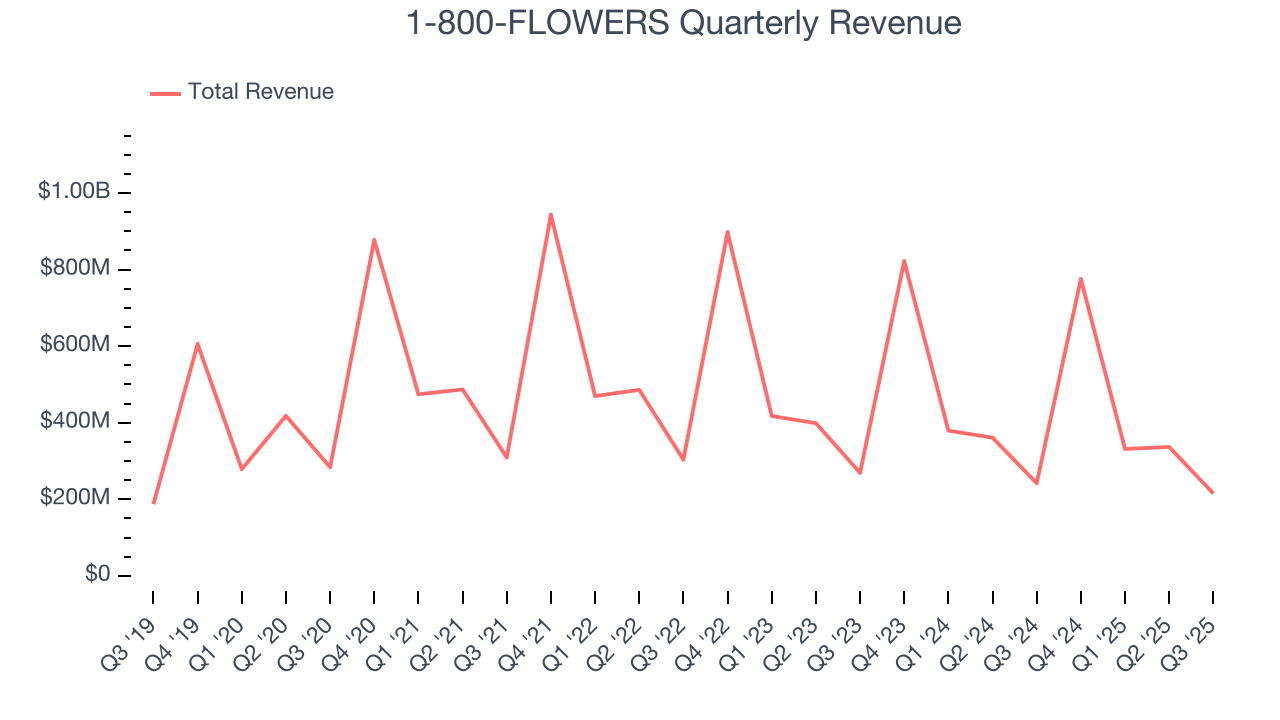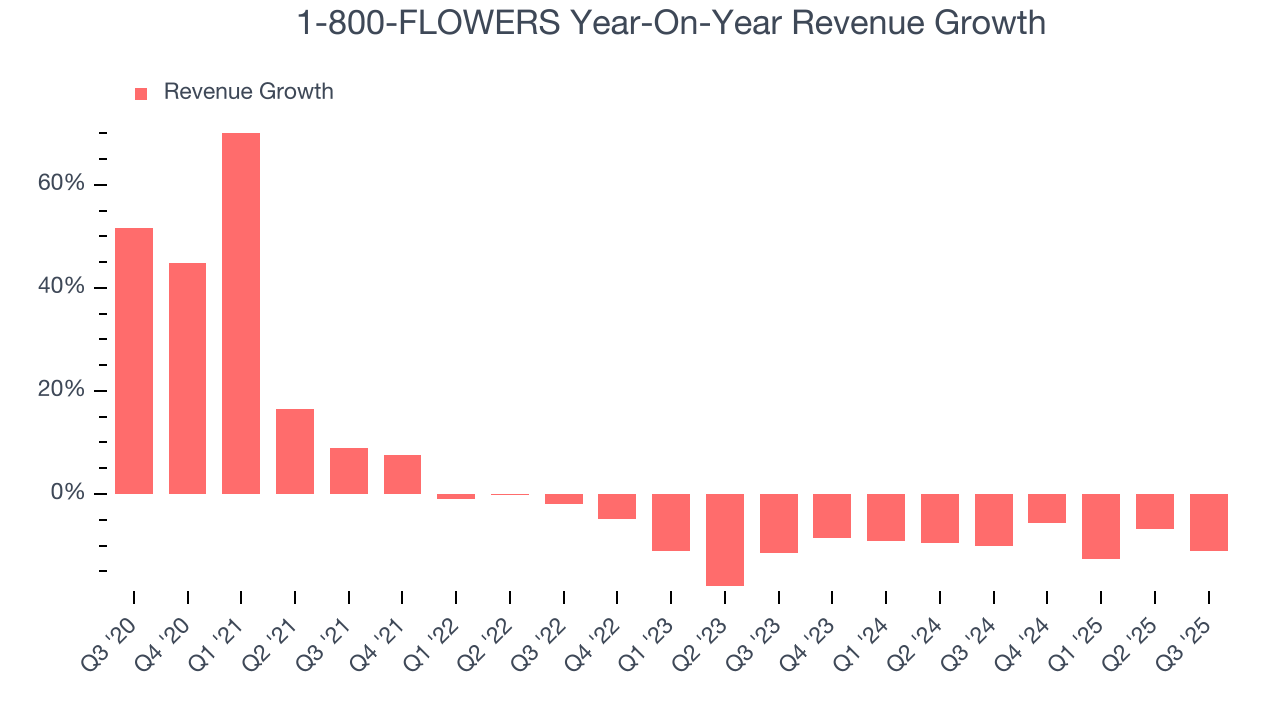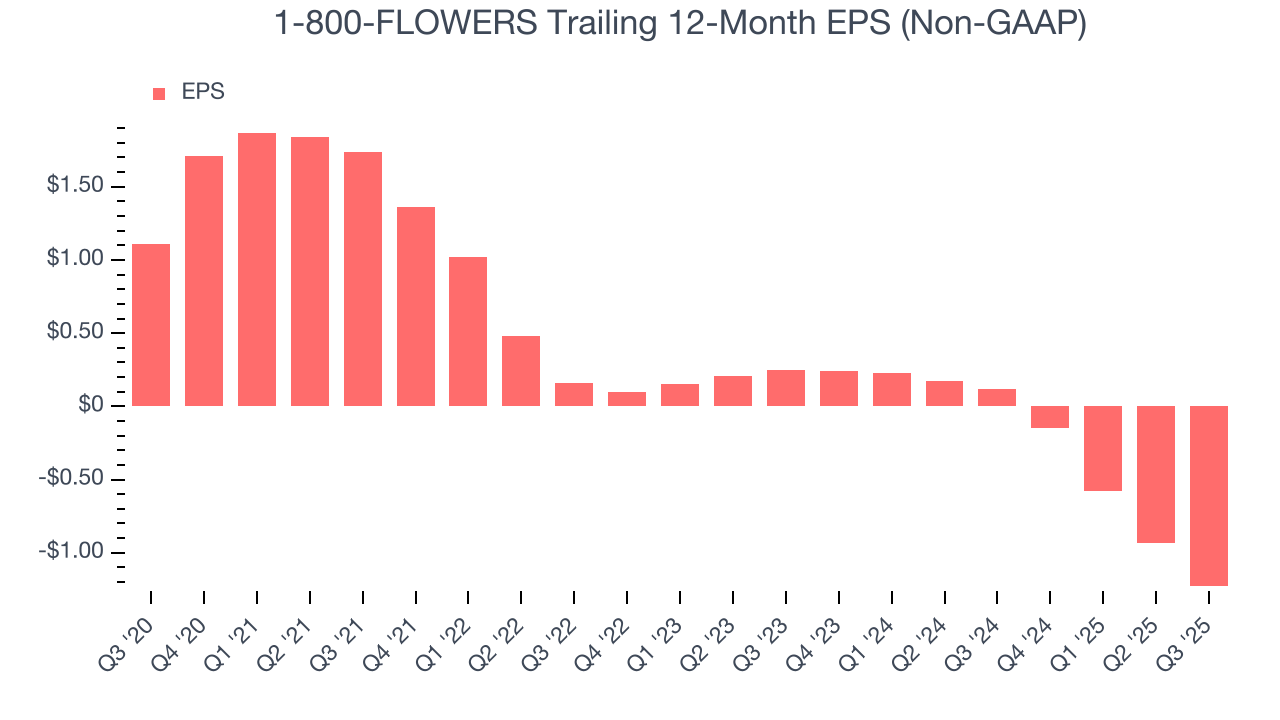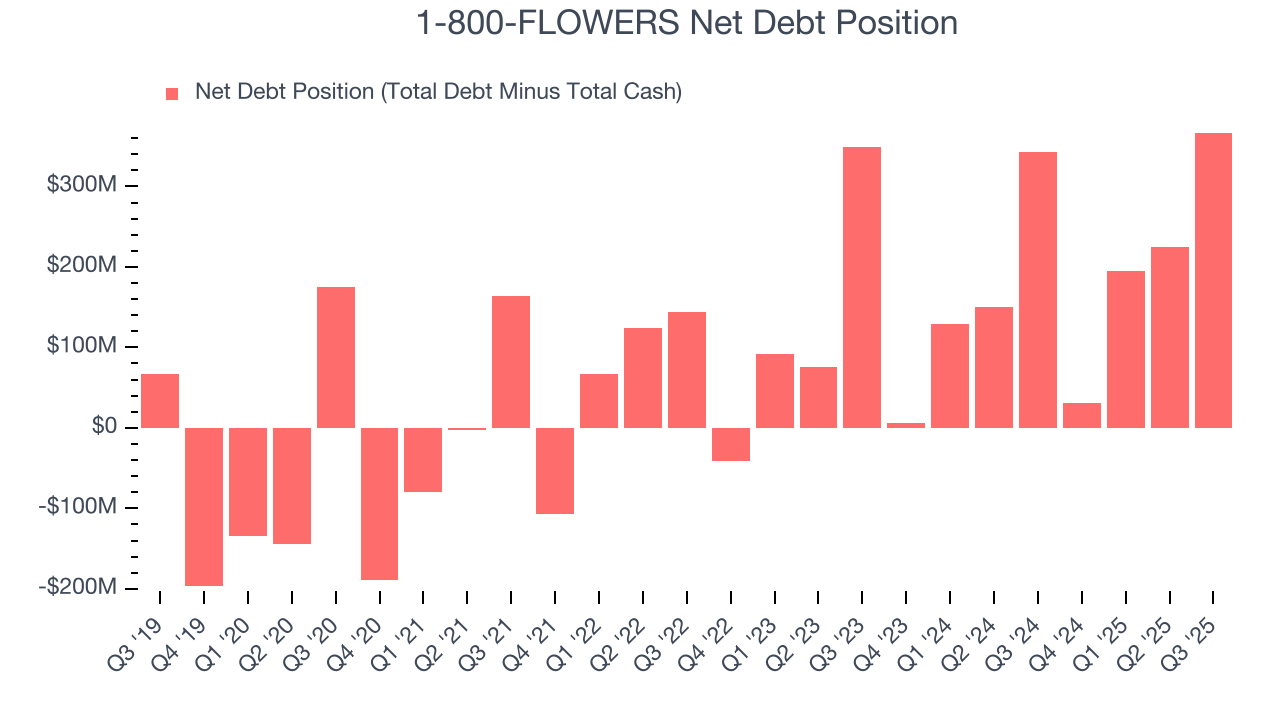
1-800-FLOWERS (FLWS)
We wouldn’t buy 1-800-FLOWERS. Its low returns on capital and plummeting sales suggest it struggles to generate demand and profits, a red flag.― StockStory Analyst Team
1. News
2. Summary
Why We Think 1-800-FLOWERS Will Underperform
Founded in 1976, 1-800-FLOWERS (NASDAQ:FLWS) is an online retailer of flowers, gifts, and gourmet foods, serving customers globally.
- Products and services fail to spark excitement with consumers, as seen in its flat sales over the last five years
- Earnings per share fell by 25.5% annually over the last five years while its revenue was flat, showing each sale was less profitable
- Limited cash reserves may force the company to seek unfavorable financing terms that could dilute shareholders


1-800-FLOWERS lacks the business quality we seek. Our attention is focused on better businesses.
Why There Are Better Opportunities Than 1-800-FLOWERS
High Quality
Investable
Underperform
Why There Are Better Opportunities Than 1-800-FLOWERS
1-800-FLOWERS is trading at $3.53 per share, or 4.4x forward EV-to-EBITDA. 1-800-FLOWERS’s valuation may seem like a bargain, but we think there are valid reasons why it’s so cheap.
We’d rather pay up for companies with elite fundamentals than get a bargain on weak ones. Cheap stocks can be value traps, and as their performance deteriorates, they will stay cheap or get even cheaper.
3. 1-800-FLOWERS (FLWS) Research Report: Q3 CY2025 Update
E-commerce florist and gift retailer 1-800-FLOWERS (NASDAQ:FLWS) fell short of the markets revenue expectations in Q3 CY2025, with sales falling 11.1% year on year to $215.2 million. Its non-GAAP loss of $0.83 per share was 29.7% below analysts’ consensus estimates.
1-800-FLOWERS (FLWS) Q3 CY2025 Highlights:
- Revenue: $215.2 million vs analyst estimates of $217.8 million (11.1% year-on-year decline, 1.2% miss)
- Adjusted EPS: -$0.83 vs analyst expectations of -$0.64 (29.7% miss)
- Adjusted EBITDA: -$32.95 million vs analyst estimates of -$32.95 million (-15.3% margin, in line)
- Operating Margin: -23.5%, down from -18.7% in the same quarter last year
- Free Cash Flow was -$145.6 million compared to -$189.3 million in the same quarter last year
- Market Capitalization: $222 million
Company Overview
Founded in 1976, 1-800-FLOWERS (NASDAQ:FLWS) is an online retailer of flowers, gifts, and gourmet foods, serving customers globally.
1-800-FLOWERS began as a single flower shop in 1976. The company's early adoption of a toll-free number and its domain name offered a new method of direct consumer access and convenience in the flower delivery service industry.
Today, 1-800-FLOWERS offers a range of products beyond flowers, including gourmet foods, gift baskets, and unique presents. This expansion reflects the company's desire to become a one-stop shop for thoughtful gifts.
The company's revenue is primarily generated through its e-commerce platform, with seasonal peaks around Valentine’s Day and Mother’s Day, and its business relies on efficient delivery networks and convenience.
4. Specialized Consumer Services
Some consumer discretionary companies don’t fall neatly into a category because their products or services are unique. Although their offerings may be niche, these companies have often found more efficient or technology-enabled ways of doing or selling something that has existed for a while. Technology can be a double-edged sword, though, as it may lower the barriers to entry for new competitors and allow them to do serve customers better.
Competitors operating in the online retail of flowers and gifts industry include Amazon (NASDAQ:AMZN), Kroger (NYSE:KR), and Walmart (NYSE:WMT).
5. Revenue Growth
A company’s long-term performance is an indicator of its overall quality. Even a bad business can shine for one or two quarters, but a top-tier one grows for years. Unfortunately, 1-800-FLOWERS struggled to consistently increase demand as its $1.66 billion of sales for the trailing 12 months was close to its revenue five years ago. This wasn’t a great result and suggests it’s a low quality business.

We at StockStory place the most emphasis on long-term growth, but within consumer discretionary, a stretched historical view may miss a company riding a successful new product or trend. 1-800-FLOWERS’s recent performance shows its demand remained suppressed as its revenue has declined by 8.5% annually over the last two years. 
This quarter, 1-800-FLOWERS missed Wall Street’s estimates and reported a rather uninspiring 11.1% year-on-year revenue decline, generating $215.2 million of revenue.
Looking ahead, sell-side analysts expect revenue to decline by 2.2% over the next 12 months. While this projection is better than its two-year trend, it’s hard to get excited about a company that is struggling with demand.
6. Operating Margin
1-800-FLOWERS’s operating margin has shrunk over the last 12 months and averaged negative 1.3% over the last two years. Unprofitable consumer discretionary companies with falling margins deserve extra scrutiny because they’re spending loads of money to stay relevant, an unsustainable practice.

1-800-FLOWERS’s operating margin was negative 23.5% this quarter. The company's consistent lack of profits raise a flag.
7. Earnings Per Share
Revenue trends explain a company’s historical growth, but the long-term change in earnings per share (EPS) points to the profitability of that growth – for example, a company could inflate its sales through excessive spending on advertising and promotions.
Sadly for 1-800-FLOWERS, its EPS declined by 25.5% annually over the last five years while its revenue was flat. This tells us the company struggled because its fixed cost base made it difficult to adjust to choppy demand.

In Q3, 1-800-FLOWERS reported adjusted EPS of negative $0.83, down from negative $0.53 in the same quarter last year. This print missed analysts’ estimates. Over the next 12 months, Wall Street expects 1-800-FLOWERS to improve its earnings losses. Analysts forecast its full-year EPS of negative $1.23 will advance to negative $0.61.
8. Cash Is King
If you’ve followed StockStory for a while, you know we emphasize free cash flow. Why, you ask? We believe that in the end, cash is king, and you can’t use accounting profits to pay the bills.
1-800-FLOWERS broke even from a free cash flow perspective over the last two years, giving the company limited opportunities to return capital to shareholders.

1-800-FLOWERS burned through $145.6 million of cash in Q3, equivalent to a negative 67.7% margin. The company’s cash burn slowed from $189.3 million of lost cash in the same quarter last year.
9. Return on Invested Capital (ROIC)
EPS and free cash flow tell us whether a company was profitable while growing its revenue. But was it capital-efficient? Enter ROIC, a metric showing how much operating profit a company generates relative to the money it has raised (debt and equity).
1-800-FLOWERS historically did a mediocre job investing in profitable growth initiatives. Its five-year average ROIC was 5.5%, somewhat low compared to the best consumer discretionary companies that consistently pump out 25%+.

We like to invest in businesses with high returns, but the trend in a company’s ROIC is what often surprises the market and moves the stock price. Unfortunately, 1-800-FLOWERS’s ROIC has decreased significantly over the last few years. Paired with its already low returns, these declines suggest its profitable growth opportunities are few and far between.
10. Balance Sheet Risk
As long-term investors, the risk we care about most is the permanent loss of capital, which can happen when a company goes bankrupt or raises money from a disadvantaged position. This is separate from short-term stock price volatility, something we are much less bothered by.
1-800-FLOWERS burned through $24.14 million of cash over the last year, and its $374.6 million of debt exceeds the $7.75 million of cash on its balance sheet. This is a deal breaker for us because indebted loss-making companies spell trouble.

Unless the 1-800-FLOWERS’s fundamentals change quickly, it might find itself in a position where it must raise capital from investors to continue operating. Whether that would be favorable is unclear because dilution is a headwind for shareholder returns.
We remain cautious of 1-800-FLOWERS until it generates consistent free cash flow or any of its announced financing plans materialize on its balance sheet.
11. Key Takeaways from 1-800-FLOWERS’s Q3 Results
We struggled to find many positives in these results. Its EPS missed and its revenue fell slightly short of Wall Street’s estimates. Overall, this quarter could have been better. The stock traded down 11.6% to $3.09 immediately after reporting.
12. Is Now The Time To Buy 1-800-FLOWERS?
Updated: December 3, 2025 at 10:00 PM EST
When considering an investment in 1-800-FLOWERS, investors should account for its valuation and business qualities as well as what’s happened in the latest quarter.
1-800-FLOWERS falls short of our quality standards. First off, its revenue growth was weak over the last five years, and analysts expect its demand to deteriorate over the next 12 months. And while its projected EPS for the next year implies the company’s fundamentals will improve, the downside is its declining EPS over the last five years makes it a less attractive asset to the public markets. On top of that, its relatively low ROIC suggests management has struggled to find compelling investment opportunities.
1-800-FLOWERS’s EV-to-EBITDA ratio based on the next 12 months is 4.4x. While this valuation is optically cheap, the potential downside is huge given its shaky fundamentals. There are more exciting stocks to buy at the moment.
Wall Street analysts have a consensus one-year price target of $6 on the company (compared to the current share price of $3.53).
Although the price target is bullish, readers should exercise caution because analysts tend to be overly optimistic. The firms they work for, often big banks, have relationships with companies that extend into fundraising, M&A advisory, and other rewarding business lines. As a result, they typically hesitate to say bad things for fear they will lose out. We at StockStory do not suffer from such conflicts of interest, so we’ll always tell it like it is.









